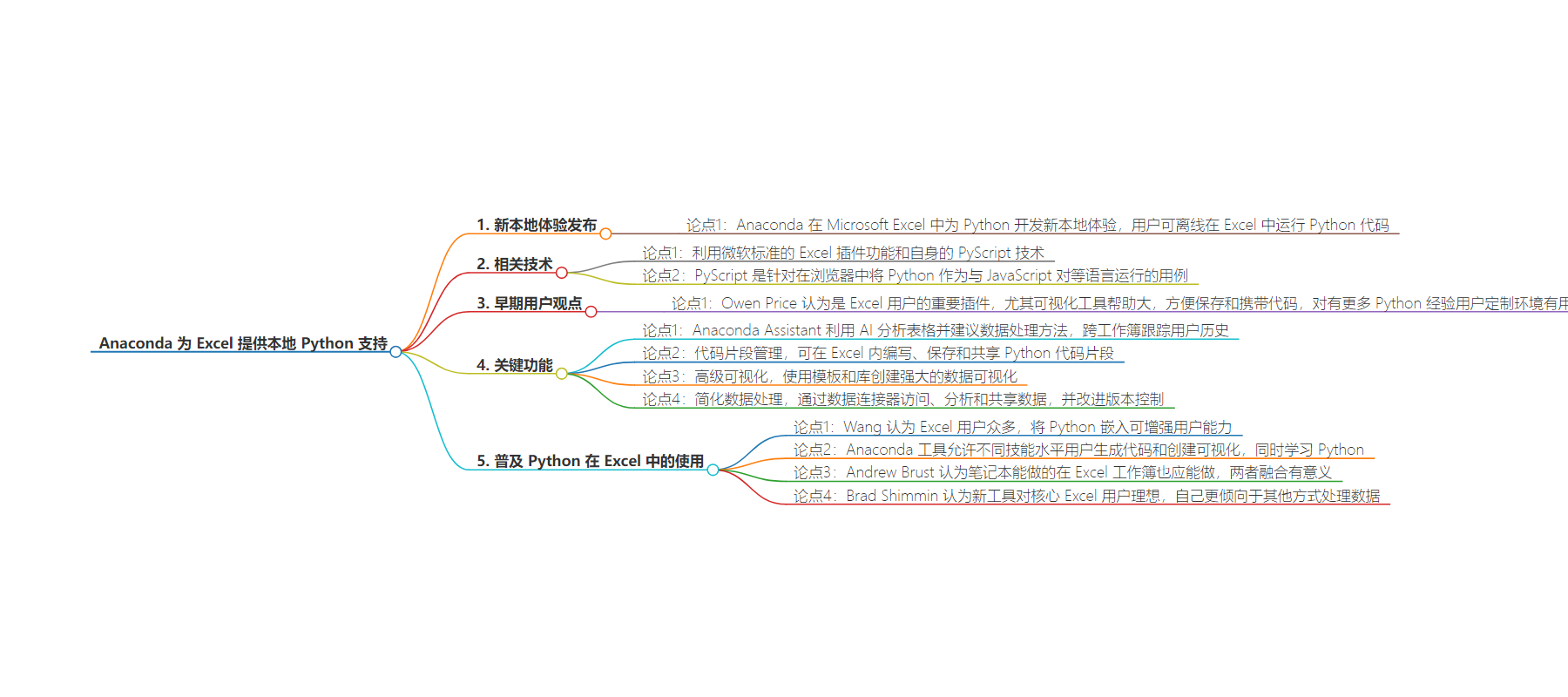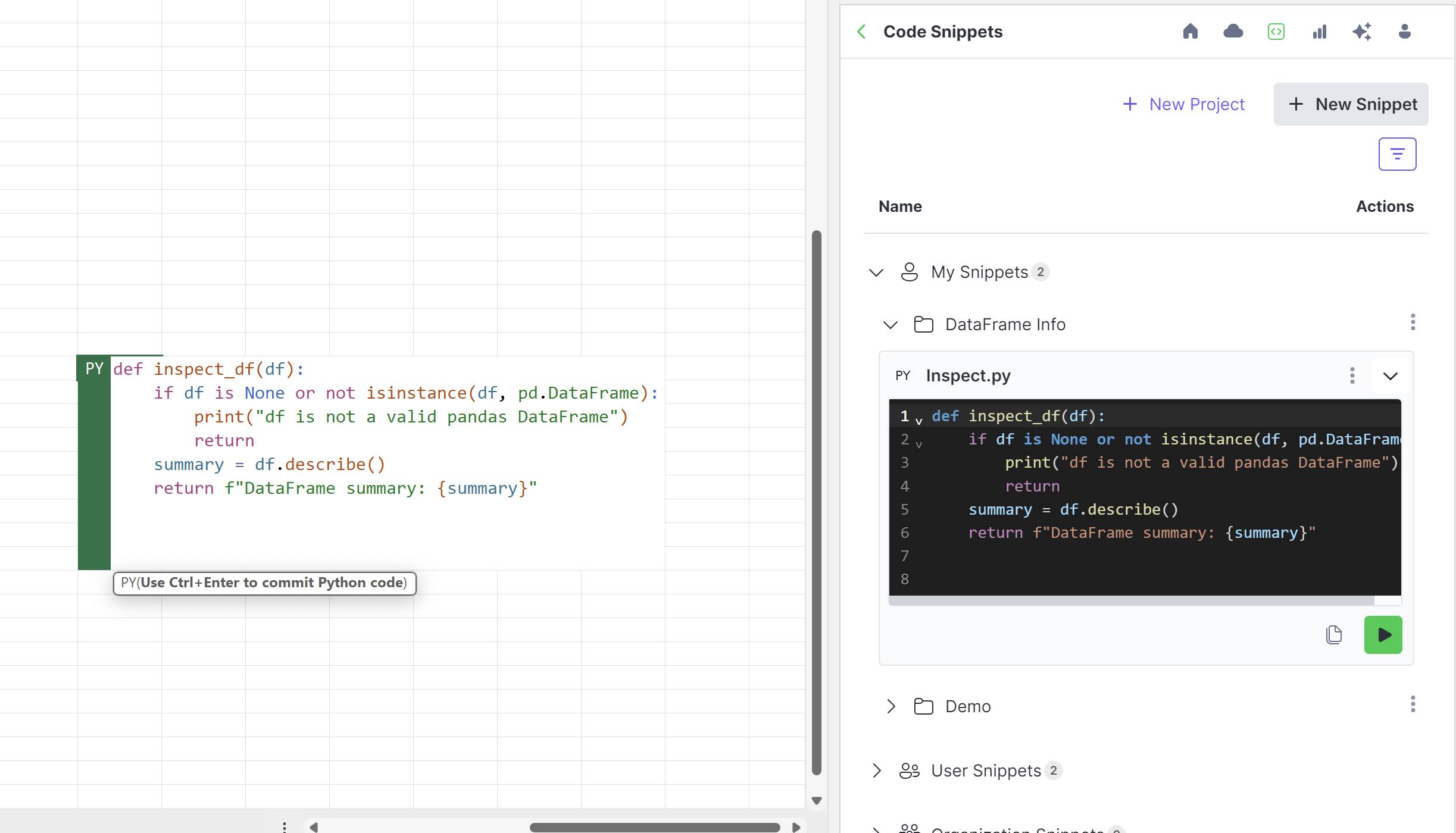包阅导读总结
1.
“`
Anaconda、Excel、Python、Local、Code
“`
2.
Anaconda 为 Microsoft Excel 开发了新的本地 Python 体验,允许用户在无网络连接时在 Excel 中运行 Python 代码。Anaconda Code 已开启公测,具有多种功能,适用于不同用户,有助于普及 Python 在 Excel 中的使用。
3.
– Anaconda 为 Excel 推出本地 Python 体验
– 宣布 Anaconda Code 在其 Anaconda Toolbox for Excel 中的公测
– 支持用户在 Excel 中直接编写和本地运行 Python 代码
– 技术实现
– 利用微软标准的 Excel 插件能力和自身的 PyScript 技术
– 基于 WebAssembly 运行本地 Python
– 早期用户观点
– 如 Owen Price 认为对 Excel 用户有很大帮助
– 关键功能
– 包括 Anaconda Assistant 等多项特色功能
– 普及 Python 使用
– 众多 Excel 用户不知如何编码但关心数据,此工具可增强其能力
– 适用于不同技能水平用户,与 Jupyter 等生态不同但有融合意义
思维导图:
文章地址:https://thenewstack.io/excel-gets-local-python-boost-with-anaconda-code/
文章来源:thenewstack.io
作者:Darryl K. Taft
发布时间:2024/7/31 18:38
语言:英文
总字数:1077字
预计阅读时间:5分钟
评分:91分
标签:Python,Excel,Anaconda,本地 Python 环境,PyScript
以下为原文内容
本内容来源于用户推荐转载,旨在分享知识与观点,如有侵权请联系删除 联系邮箱 media@ilingban.com
Anaconda has developed a new local experience for Python in Microsoft Excel, allowing users to run Python code within Excel spreadsheets without an internet connection.
Today, Anaconda announced the public beta release ofAnacondaCode within itsAnacondaToolbox for Excel.AnacondaCode empowers users to write Python code directly within Excel and run it locally.
Peter Wang, Anaconda’s co-founder and chief of AI and innovation, told The New Stack that the company created this capability “to support one of the most requested features that early users and customers had, which is that, they like the ability of being able to do Python in Excel, but for a variety of reasons they may want to be running that locally, within their on their own machine, versus having that connection to Azure.”
Anaconda introduced Python in Excelin August of last year to enable users to perform data manipulation, analysis, and visualization, as well as advanced machine learning and AI tasks, directly within Excel spreadsheets. But until now, the Python code would run on Microsoft Azure’s secure cloud servers.
WebAssembly, JavaScript Connection
To provide Python in Excel locally, Anaconda used Microsoft’s standard, existing Excel plugin capabilities, and applied their own Python on WebAssembly (WASM) technology called PyScript, which is primarily targeted towards the use case of running Python as a peer language to JavaScript in the browser.
“If there is a Python interpreter in Excel, then we could run PythonMonkey in it, and therefore open JavaScript up inside Excel as well potentially. Probably do the reverse in Google Sheets as well, Dan Desjardins, CEO and co-founder of Distributive, the maker of the PythonMonkey Python library for executing JavaScript in Python, told The New Stack.
Indeed, wherever there’s Python, you also have JavaScript for free via PythonMonkey; compounding value and use cases, he noted.
“Anaconda Code’s local runtime is powered by Anaconda’s open source PyScript technology,which uses WASM,to run Python locally on your computer through any browser,” Wang told the New Stack. “Excel Add-Ins are browser-based panes that interact with and run in Excel. Anaconda Code creates the local Python WASM runtime and your code is run securely and locally. You can write your Python code in the add-in and the results are displayed in Excel.”
Early User Perspective
Meanwhile, Owen Price, a Microsoft MVP and trusted voice of the Python in Excel community, just happened to start working at Anaconda this week, said he first used Anaconda Toolbox during the early preview last year, keen to understand what tools were on offer to enhance the Python experience in Excel.
“It’s a significant add-in for Excel users looking to level up and harness the additional power and convenience of Python in Excel,” he told The New Stack. “In particular, the visualization tools will be a massive help for users. People are going to love the ability to save their code and have it portable between workbooks.”
Moreover, “Anaconda Code will be a huge help to those with perhaps a little more experience with Python who want to customize their environment and make use of a tailored set of packages for their specific use cases,” Price said. “All of this integrated with Excel allows users to be more efficient and productive while removing the work of environment management, giving them more time to solve complexproblems.”
Key Features
Excel users withAnacondaToolbox will now have access to:
- Anaconda Assistant:Utilize AI to analyze tables and suggest data handling methods with history following users across workbooks for consistent code use.
- Code Snippet Management:Write, save, and share Python code snippets directly within Excel, enhancing productivity and collaboration.
- Advanced Visualizations: Create powerful data visualizations using accessible templates and libraries, easily integrated into Excel worksheets.
- Streamlined Data Handling: Use data connectors to access, analyze, and share data in Excel workbooks orAnaconda.cloud notebooks with improved versioning to ensure access to the most current datasets.

The Anaconda Toolbox in Excel makes Python accessible to all users, enabling code generation, efficient visualizations, and seamless collaboration through Anaconda.cloud notebooks.
Democratizing Python Use Within Microsoft Excel
Wang estimated that there are we have something like 40 to 50 million Anaconda (read Python) users, but Excel has hundreds of millions of users, he noted.
“Many of them don’t know how to code, but they do know how to think. They do care about data. They care about reasoning and what’s happening in their business, what’s happening in their supply chain,” Wang said. “There are a lot of scientists and engineers who don’t code, but who are brilliant, and they use Excel as a tool for looking at data. At my first job as a quantum physicist, my quantum physics mentor at Los Alamos National Lab, preferred to use Excel primarily to look at all this data coming off of the trifold quantum computer.
“So there are many people out there for whom Excel is a natural tool, and that’s why I think, when we can take Python, which we use to democratize data analysis for lots of people, and we can embed it into Excel, we can then add more power to all these people who are already in that environment.”
Wang said AnacondaToolbox for Excel allows users of all skill levels to generate code and create visualizations efficiently, while simultaneously learning Python.
“Between Microsoft and Anaconda, a premise seems to have emerged that anything doable in a notebook should be doable in an Excel workbook as well,” Andrew Brust, founder and CEO of Blue Badge Insights, told The New Stack. “At the foundation, that means data access, transformation, preparation, and visualization; on the AI side, it means machine learning (both training and inference) and even generative AI/RAG. Jupyter and other notebook platforms have established robust ecosystems.
“But Excel has a developer ecosystem of its own, going back to the days of macros, XLLs, and Visual Basic for Applications (VBA). Rather than leaving the two worlds siloed, it makes sense to mash them up, since spreadsheet jockeys and data scientists coding in Python both work with formulas, datasets, models and visualizations.”
Brad Shimmin, an analyst at Omdia, said he believes the new Anaconda tool is ideal for core Excel users. Still, he would rather use Jupyter Notebooks and PandasandNumPyor Python inVS Code for his data manipulation needs.
YOUTUBE.COM/THENEWSTACK
Tech moves fast, don’t miss an episode. Subscribe to our YouTubechannel to stream all our podcasts, interviews, demos, and more.
